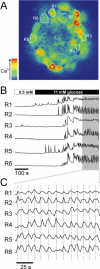Oscillations, intercellular coupling, and insulin secretion in pancreatic beta cells
- PMID: 16464129
- PMCID: PMC1363709
- DOI: 10.1371/journal.pbio.0040049
Oscillations, intercellular coupling, and insulin secretion in pancreatic beta cells
Abstract
Insulin is a potent metabolic regulator that is released by pancreatic beta-cells, which respond to body glucose concentrations. Here the authors explain the physiological basis of insulin release.
Conflict of interest statement
The authors declare that no competing interests exist.
Figures


References
-
- Sanvito F, Herrera PL, Huarte J, Nichols A, Montesano R, et al. TGF-beta 1 influences the relative development of the exocrine and endocrine pancreas in vitro. Development. 1994;120:3451–3462. - PubMed
-
- LeRoith D. Beta-cell dysfunction and insulin resistance in type 2 diabetes: Role of metabolic and genetic abnormalities. Am J Med. 2002;113(Suppl 6A):3S–11S. - PubMed
-
- Kahn SE. The importance of the beta-cell in the pathogenesis of type 2 diabetes Mellitus. Am J Med. 2000;108(Suppl 6a):2S–8S. - PubMed
Publication types
MeSH terms
Substances
Grants and funding
LinkOut - more resources
Full Text Sources
Medical

